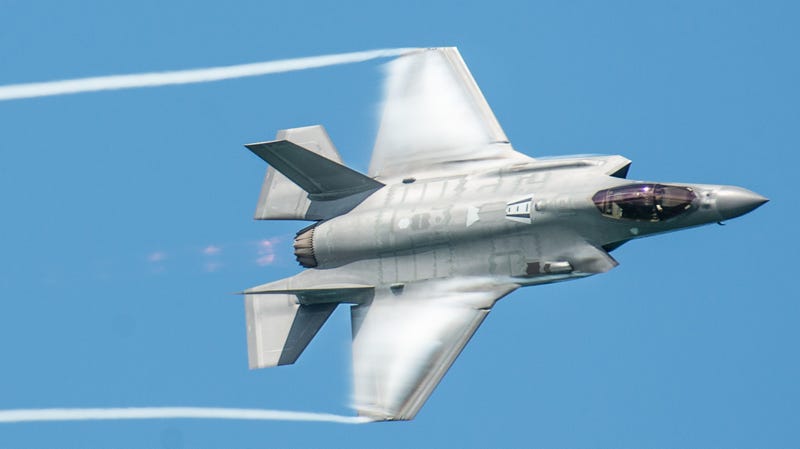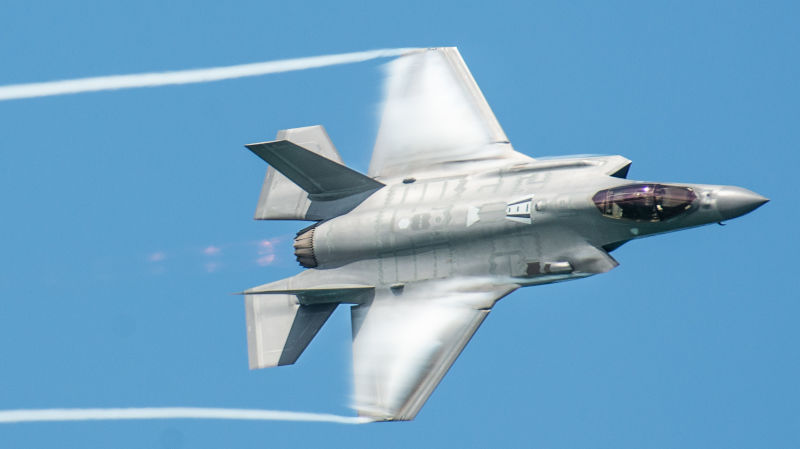
 Foxtrot AlphaTech and news from the world of modern defense.
Foxtrot AlphaTech and news from the world of modern defense.The F-35’s myriad problems are really now just a running gag. But its latest ones are wild, ranging from buyers feeling that they’re being spied on through the jets to the potential for structural damage if flown fast at very high altitudes, which is something that fighter jets are known to do from time to time. Oh, and the possibility pilots could experience sudden, agonizing nose and ear pain.
Defense News did a time-on-target on the F-35 Lightning II last week, publishing several articles in a single day exploring issues with the most expensive fighter jet—and defense program—in known human history. In a multi-part series called, “The Hidden Troubles of the F-35,” Defense News took a look at several of the issues plaguing F-35 users.

One of the biggest problems with the F-35 is one enjoyed by foreign customers, who complained that the aircraft’s Advanced Logistics Information System, or ALIS, phones home with too much “sovereign data.” The ALIS is designed by Lockheed Martin to coordinate worldwide F-35 issues, repairs, and spare parts, collecting data from every jet worldwide.
Advertisement
Foreign customers of the jet complained ALIS phones home data that could be used to keep tabs on their operations. The issue was reportedly serious enough that two foreign operators threatened to walk away from the entire F-35 program unless the problem is fixed. The Department of Defense and Lockheed Martin are reportedly working on a fix that addresses sovereign data issues, Defense News reported.
Definitely a bug for them, but probably a feature for the U.S.
Another major problem is the F-35 can only be flown at supersonic speeds at very high altitudes for short periods of time, or risk damage to the antennas on the aircraft:
At extremely high altitudes, the U.S. Navy and Marine Corps’ versions of the F-35 jet can only fly at supersonic speeds for short bursts of time before there is a risk of structural damage and loss of stealth capability, a problem that may make it impossible for the Navy’s F-35C to conduct supersonic intercepts.
The Defense Department does not intend to field a fix for the problem, which influences not only the F-35’s airframe and the low-observable coating that keeps it stealthy, but also the myriad antennas located on the back of the plane that are currently vulnerable to damage, according to documents exclusively obtained by Defense News.
Advertisement
The Pentagon and Lockheed Martin are aware of other problems, many of which are allegedly in the process of being solved. At least two cases of cockpit pressure spikes left pilots with what sounds like horrific ear and nose sinus pain, a condition similar to what airline passengers sometimes experience during takeoffs and landings if you’ve got a sinus infection, but this sounds way worse, Defense News reports (emphasis ours):
“There is no indication from the fleet that this ear and sinus pain issue is widespread,” read one document obtained exclusively by Defense News. Only two Air Force test pilots using early versions of the F-35 have experienced extreme incidents of barotrauma — the word given to ear injuries that occur due to changes in air pressure.
“[The] pain has been described as excruciating, causing loss of in-flight situational awareness, with effects lasting for months,” the document states.
Advertisement
Another issue is that a blown tire may damage the plane’s hydraulic lines, potentially causing causing a loss of control during the landing process. This in turn could lead to what the Pentagon calls “runway departure” and the possible loss of aircraft. The issue has reportedly been fixed in the -C Navy carrier version but Defense News says it may never be fixed in the Air Force and Marine Corps versions.

Advertisement
The Defense News reports are just relentless. The F-35B, the short-take-off-vertical-landing variant, is apparently having problems with the whole vertical-landing bit in hot-and-high conditions. F-35s operating in very cold conditions are getting false battery failure warnings, forcing the aircraft to cut training flights short. Navy and Marine Corps F-35s become unpredictable when exceeding a 20 degree angle of attack.Problems with the aircraft’s maintenance and logistics software are leading to groundings and issues with the $400,000 pilot helmet system leave pilots unable to see the horizon line and important navigational cues.
Again, flying around, seeing the horizon, and navigational directions are sort of the things you need in a fighter jet.
Advertisement
For its part, Lockheed Martin swiftly issued a statement responding to each of the major problems cited in the articles. The company stated that“these issues are important to address, and each is well understood, already resolved or on a near term path to resolution.”
The F-35 program has already cranked out 400 jets and worldwide the Joint Strike Fighter fleet has amassed 200,000 flight hours. The jet isn’t going anywhere. That having been said some of these issues are serious, and the sooner they’re fixed the better.
Advertisement
Go read the whole Defense News series here.













